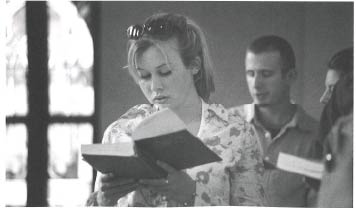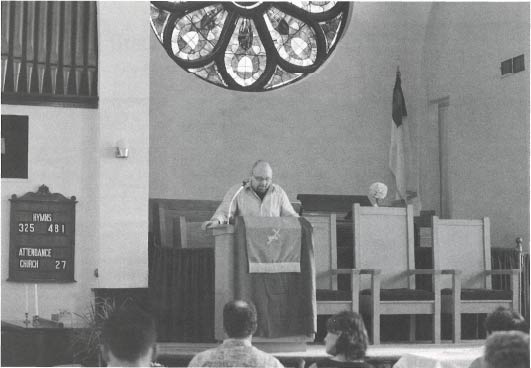Updated May, 2025
The hundred-year-old church building where Grace Central Presbyterian (PCA) Church worships sits in the heart of the Short North arts district of Columbus, Ohio. It’s a neighborhood known for its unabashed creativity and eclectic character. Located between downtown Columbus and Ohio State University, the name comes from the shorthand term police used for the area in the 1970s and early ’80s when it suffered from a high crime rate. Since its revitalization, the Short North’s brick streets and historic buildings have become home to small galleries, shops, and restaurants. Several large murals put a new twist on famous works of art—picture the Mona Lisa painted sideways and the woman in American Gothic painted upside down.
Grace Central fits in here. Deeply rooted in the Reformed tradition, its worship is structured on an adaptation of Calvin’s Geneva liturgy, which is printed in the bulletin. The congregation sings hymns from the hymnal, but even those old familiar words and songs seem fresh and new at this church. It’s like those murals—even though I’ve seen American Gothic hundreds of times, the mural always gives me pause.
Senior pastor Greg Blosser, 32, describes the church as self-consciously Presbyterian without taking itself too seriously. His preaching is expository and substantive. Blosser draws on experiences that are relevant to this community—such as his indie music collection, his role as the father of three young children, and discussions with atheist friends.
The church was planted less than three years ago by two churches in the suburbs of Columbus: Northwest Presbyterian Church in Dublin and Walnut Creek in Gahanna. Their goal was to create a vibrant church community in the heart of the city. Grace Central rents its building from another PCA church, and the stained glass windows and bare pews fit well for this congregation that cares deeply about tradition, the arts, and the city.

Old Words, New Audience
When I asked Blosser why the church decided to follow a written liturgy in the first place, he says it was “an attempt at survival.” With all the obligations of planting a church, following a predictable worship format was one way to keep things both simple and theologically sound.
“I see liturgy as a conversation between God and us, and I love that,” says Blosser.
He never thought that following a traditional liturgy would prevent the church from reaching out to its neighbors. “I didn’t think the liturgy would turn people off,” he says. “I don’t think people really care if you’re following a liturgy; they want something real.”
From his delivery at the pulpit, it’s obvious that Blosser believes the words of the liturgy, and he translates them into a conversational tone that resonates with the congregation.
“My favorite part is the absolution of sins. To hear that proclaimed in a group setting is freeing, and to be the one to say it is very fulfilling.” He pauses. Since I’ve worshiped at Grace Central for about nine months, I know he’s not finished. “And the call to worship, I love that part . . . and the benediction . . . .”
Revisited Hymns
Deciding on what music to use in the worship service was about practicality and theology too. Blosser says, “I had a huge stack of music to look through, and I knew these hymns had been sung in churches for hundreds of years and were based on biblical truths, so I gave the musicians the hymns.”
In a typical worship service at Grace, the congregation sings the first hymn from the hymnal and the rest from the lyrics printed in the bulletin. The songs are freshly arranged and accompanied by acoustic guitars, occasional percussion, and a group of singers.
Musicians rotate weekly. They collectively decide what to play—a method of collaboration that allows multiple people to use and develop their gifts and prevents having the same person leading each week. This has served them and the congregation well.
The music is calmly assuring. Singing the same lyrics that my great-great-grandparents sang reminds me that God’s relationship with his people is unchanging.
The musicians also compose fresh arrangements of familiar old hymns such as “Jesus, I Come,” written by William T. Sleeper in 1887. Musical styles change, but the lyrics are universal: “Out of my bondage, sorrow, and night, Jesus, I come, Jesus, I come; into Thy freedom, gladness, and light, Jesus, I come to Thee.”
As Grace Central has matured, musicians have included a few modern hymns in the worship service. These songs, such as “You have Redeemed My Soul [from the Pit of Emptiness]” by Don Chaffer and “She Must and Shall Go Free” by Derek Webb bring a strong message of restoration and redemption. In other words, the music speaks to the congregation about the timeless nature and saving work of God.

Gospel Is Central
“Gospel” is a word that’s said often at Grace Central. Christ’s sacrifice and God’s grace extended to us are emphasized weekly.
Blosser is currently preaching through Romans, tackling the book verse by verse. He doesn’t gloss over the tough issues. When he came to the predestination verses in Romans 9, he invited the church to write questions about the topic on cards.
There are, of course, no easy answers to the questions on those cards, or the other questions that are raised when studying theological texts deeply. The congregation openly wrestles with these and other issues that are raised in worship. One way it does so is in small groups that meet in homes during the week to study the Scriptures in a smaller setting.
Center of the City
Grace Central began with the intention of creating a church that adhered to orthodoxy and also remained relevant to the culture of the city and the neighborhood.
“Culturally, the Short North is the center of the city. Artists drive culture,” Blosser says.
He may be right, but he’s also a bit biased. Blosser has an art degree from Miami University, Ohio, and considers this training as essential in equipping him to be a pastor at Grace Central. “My art education was no less preparation for being the pastor of this church than seminary was,” he says.
“When you’re a Christian kid who’s an art major at a state school, you learn pretty quickly how to be a good neighbor in a pluralistic society.”
Blosser says his background in fine arts has also helped him to see beauty and relevance in Scripture without always deducing tidy answers. “The arts are about ambiguity and polyvalence, while exegetes and preachers tend to see their job exclusively in terms of clarity and precision. [Ambiguity] is, under some conditions, a more adequate way of communicating biblical truths than an unhealthy preoccupation with precision.”
Blosser speaks the language of artists. He talks about his favorite theologians and his favorite independent musicians with the same eloquence. He and the other leaders in the church look like creative people. He usually preaches wearing plastic-framed glasses and jeans. Blosser is the perfect fit for a congregation of the creative people who love the Short North.

Growing Up
Because of their commitment to the neighborhood, the church plans to maintain a long-term presence. They seek to grow into a strong church slowly and consistently over a long period instead of growing quickly and then fading as new trends emerge.
Grace Central has steadily grown to about forty-five members, with as many as ninety-five gathering for worship during the school year. The fact that many in the congregation are young (most are under the age of 40) and in transitional periods in their lives presents some unique challenges.
Blosser says that the average time someone is with the church is just 18 to 24 months. This summer, nearly 20 members moved away to take new jobs or to further their education. So the church is trying to build teaching and discipleship into that short window.
At Grace Central the basics—living the gospel and loving your neighbor—are paramount. And the worship service, from the simple bare pews, to the acoustic music, to the expository preaching, proclaims the simple beautiful truths that are transforming this community.
